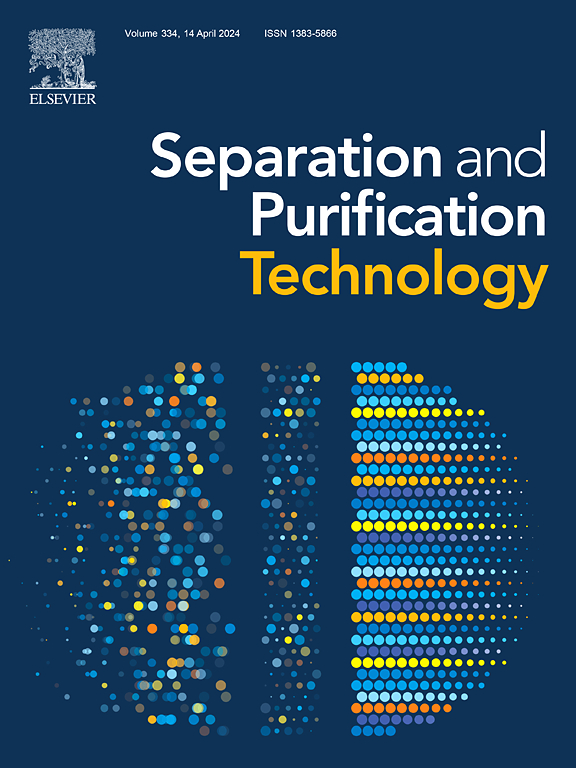具有协同不饱和Co-Cu双活性位的Co3CuAl-LDH上PMS活化的难降解有机污染物的超快降解:增强的电子转移机制
IF 9
1区 工程技术
Q1 ENGINEERING, CHEMICAL
引用次数: 0
摘要
基于过氧单硫酸盐(PMS)的高级氧化法是一种很有前途的水处理技术。然而,如何提高PMS活性以快速去除复杂水体中的顽固性有机污染物仍然是一个很大的挑战。本研究开发了一种具有丰富氧空位(Ov)的超薄三元钴层双氢氧化物(LDH)催化剂,可暴露协同不饱和Co-Cu双金属活性位点,通过“一石二鸟”的策略实现PMS氧化和还原同时生成ROS,实现难降解有机污染物的超快速消除。理论和实验结果表明,Co-Cu配对位点的协同作用加速了Co2+/Co3+和Cu+/Cu2+的氧化还原循环,增强了PMS的活化。值得注意的是,Ov的存在微调了相邻Co/Cu位点的电子结构,增强了这些不饱和金属位点与PMS之间的电子转移,使金属位点能够自我再生,从而协同促进自由基(SO4•−)和非自由基(1O2)的产生。因此,以磺胺甲恶唑(SMX)为探针的催化剂表现出显著的催化活性(13.27 min−1),明显超过目前最先进的非均相催化剂约15-393倍。在自行设计的类fenton过滤器的放大实验中,SMX的去除率在连续运行10 h后仍然达到100%,在相同的运行条件下,实际煤化工废水(235 mg·L−1)的化学需氧量去除率达到84%,在实际废水的深度处理中具有很大的潜力。这项工作为LDH电子转移增强PMS活化提供了有价值的见解,并阐述了其在水处理中的应用前景。本文章由计算机程序翻译,如有差异,请以英文原文为准。


Ultrafast degradation of refractory organic pollutants via PMS activation over Co3CuAl-LDH with coordinatively unsaturated Co-Cu dual active sites: Enhanced electron transfer mechanism
Peroxymonosulfate (PMS)-based advanced oxidation process is a promising technology for water treatment. However, there is still a great challenge on enhancing the PMS activation for the rapid removal of recalcitrant organic pollutants in complex waters. Herein, we developed an ultra-thin ternary CoCuAl-layered double hydroxide (LDH) catalyst with abundant oxygen vacancy (Ov), enabling the exposure of coordinatively unsaturated Co-Cu dual-metal active sites, which mediates “two birds with one stone” strategy to realize simultaneous PMS oxidation and reduction for ROS generation, achieving ultrafast elimination of refractory organic pollutants. Theoretical and experimental results reveal that the synergistic effect of Co-Cu paired sites accelerates redox cycles of Co2+/Co3+ and Cu+/Cu2+, strengthening PMS activation. Notably, the presence of Ov fine-tunes the electronic structure of adjacent Co/Cu sites, which enhances electron transfer between these unsaturated metal sites and PMS, enabling self-regeneration of metal sites, thereby synergistically promoting the productions of radicals (SO4•−) and nonradicals (1O2). Consequently, the catalyst exhibits remarkable catalytic activity (13.27 min−1) using sulfamethoxazole (SMX) as the probe, significantly surpassing those of state-of-the-art heterogeneous catalysts by approximately 15–393 times. The removal efficiency of SMX is still reached 100 % after 10 h of continuous operation in a scale-up experiment using a self-designed Fenton-like filter, and 84 % of chemical oxygen demand from real coal chemical wastewater (235 mg·L−1) is removed under the same operating conditions, marking the alluring potential in advanced treatment of actual wastewater. This work provides valuable insights into electron transfer-enhanced PMS activation by LDH and elaborates its prospects in water treatment applications.
求助全文
通过发布文献求助,成功后即可免费获取论文全文。
去求助
来源期刊

Separation and Purification Technology
工程技术-工程:化工
CiteScore
14.00
自引率
12.80%
发文量
2347
审稿时长
43 days
期刊介绍:
Separation and Purification Technology is a premier journal committed to sharing innovative methods for separation and purification in chemical and environmental engineering, encompassing both homogeneous solutions and heterogeneous mixtures. Our scope includes the separation and/or purification of liquids, vapors, and gases, as well as carbon capture and separation techniques. However, it's important to note that methods solely intended for analytical purposes are not within the scope of the journal. Additionally, disciplines such as soil science, polymer science, and metallurgy fall outside the purview of Separation and Purification Technology. Join us in advancing the field of separation and purification methods for sustainable solutions in chemical and environmental engineering.
 求助内容:
求助内容: 应助结果提醒方式:
应助结果提醒方式:


